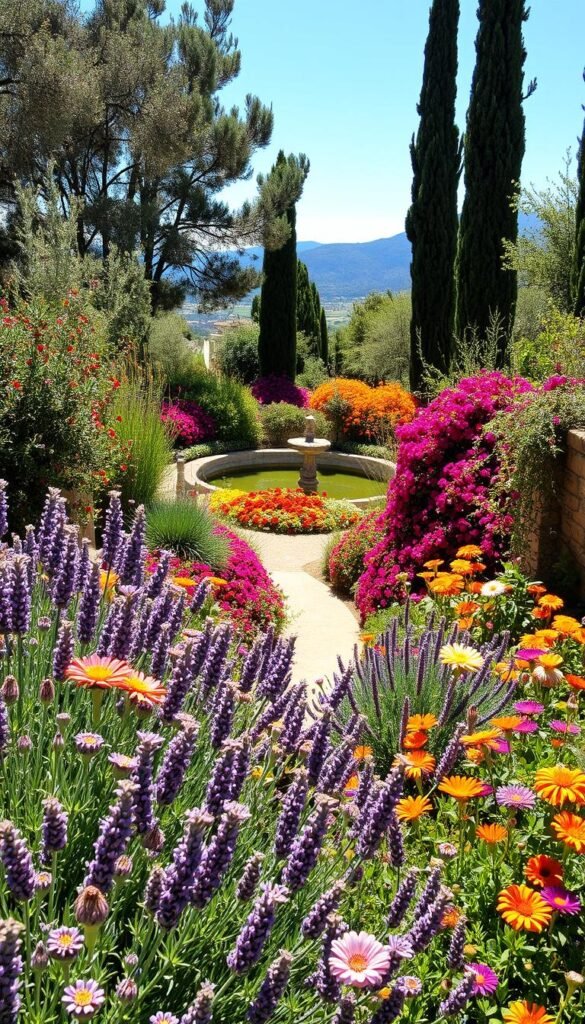Imagine stepping into an outdoor space that feels like a permanent vacation. Rustic textures mingle with fragrant herbs, while sunlight dances across terracotta pots and weathered stone paths. This is the magic of a style inspired by coastal regions where life moves at a slower pace.
These spaces prioritize harmony with nature, blending earthy materials like gravel and aged wood with drought-tolerant plants. Lavender, olive trees, and succulents thrive here, offering bursts of color without constant watering. It’s a practical choice for dry climates, but also a celebration of simplicity that invites relaxation.
What makes this approach special? It’s more than aesthetics—it’s about creating a sensory experience. The murmur of a small fountain, the scent of rosemary, and the crunch of gravel underfoot work together to transport you. Many homeowners are now embracing these ideas to elevate their outdoor spaces with timeless charm.
You’ll discover how this philosophy turns yards into retreats that mirror the easygoing spirit of seaside villages. From selecting weather-resistant furniture to incorporating native plants, every detail fosters a connection to the environment. The result? A living area that feels both effortless and intentional—perfect for gatherings or quiet moments alike.
Embracing the Mediterranean Aesthetic
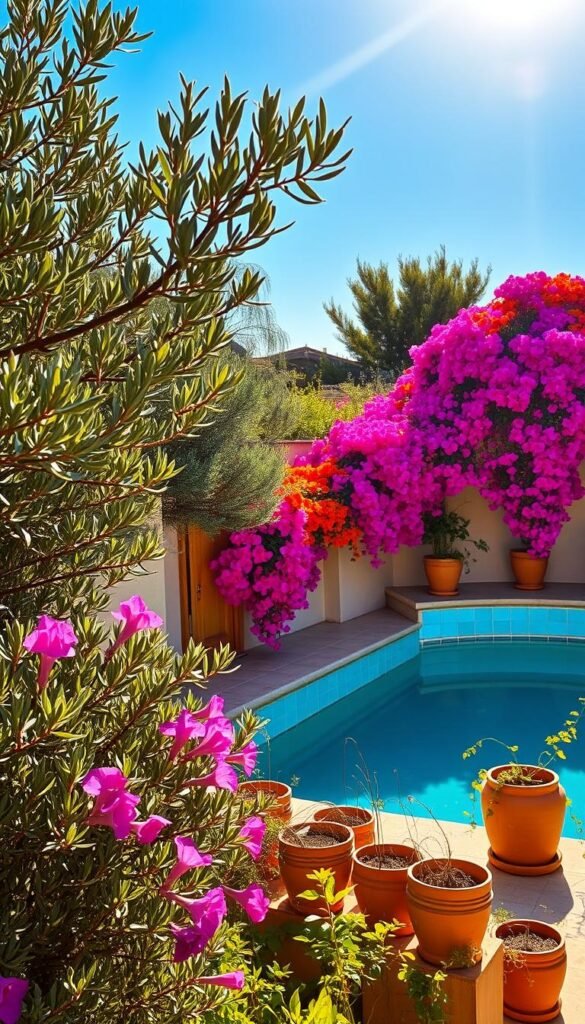
Picture a landscape where every detail tells a story of coastal living. This style blends natural elements with cultural influences, creating spaces that feel both timeless and alive. Let’s explore how to capture this balance in your own backyard.
The Harmony of Nature and Culture
These outdoor spaces thrive on natural materials that age beautifully. Rough stone walls meet polished ceramic tiles, while iron accents add old-world charm. It’s about mixing practical choices with artistic touches that reflect seaside traditions.
Colors play a starring role here. Think cobalt blues that mirror ocean waves and earthy reds reminiscent of clay rooftops. These sun-drenched hues work together to create warmth even in cooler climates.
Key Visual Elements and Inspirations
Texture adds depth to every corner. Smooth stucco walls contrast with pebble mosaics underfoot. Wrought iron lanterns cast patterns that dance in the breeze, completing the sensory experience.
| Color Inspiration | Material Pairing | Texture Example |
|---|---|---|
| Sea Blue | Terracotta Pots | Rough Stone |
| Mustard Yellow | Aged Wood | Smooth Tiles |
| Terracotta Red | Wrought Iron | Peeled Bark |
This approach adapts beautifully to different spaces. Whether working with a small patio or sprawling yard, focus on durable materials and colors that echo nature’s palette. The result? A retreat that feels both curated and carefree.
Planning Your Mediterranean Garden Layout
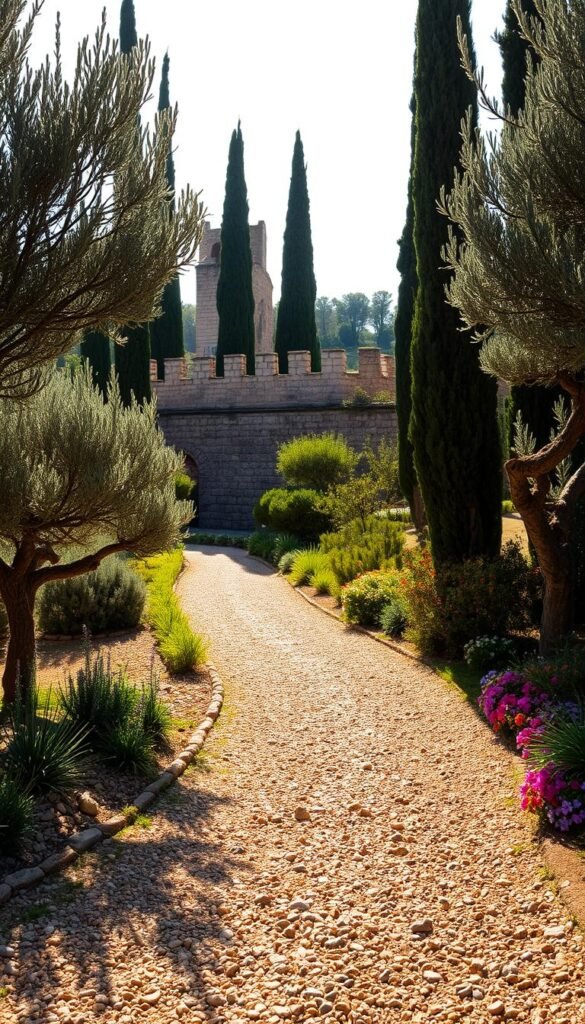
Transform your backyard into a sunlit sanctuary by first understanding your landscape’s unique potential. Smart planning turns challenges like dry soil or uneven terrain into opportunities for authentic charm.
Assessing Your Outdoor Space
Start by tracking sunlight patterns. Most plants thrive with 6-8 hours of direct sun—position seating areas and flower beds accordingly. Test your soil drainage by digging a 12-inch hole: if water pools after rain, consider raised beds filled with gritty mix.
Identify problem spots where water collects. Replace soggy zones with rock gardens or Mediterranean-inspired layouts using decomposed granite. These adjustments create ideal growing conditions while reducing maintenance.
Designing Functional Pathways and Zones
Map out routes connecting key features like dining patios and relaxation corners. Crushed gravel offers affordability and that signature crunch underfoot. For high-traffic areas, pair flagstone paving with creeping thyme between joints.
Divide your space into purposeful sections:
• Sunny terrace for herbs
• Shaded lounge under a pergola
• Central courtyard with drought-tolerant blooms
This zoning approach creates flow while celebrating the casual elegance of coastal living. Proper planning ensures every element works together—no wasted space, just effortless beauty.
Mediterranean Garden Design: Warm, Sun-Kissed, and Inviting Landscapes
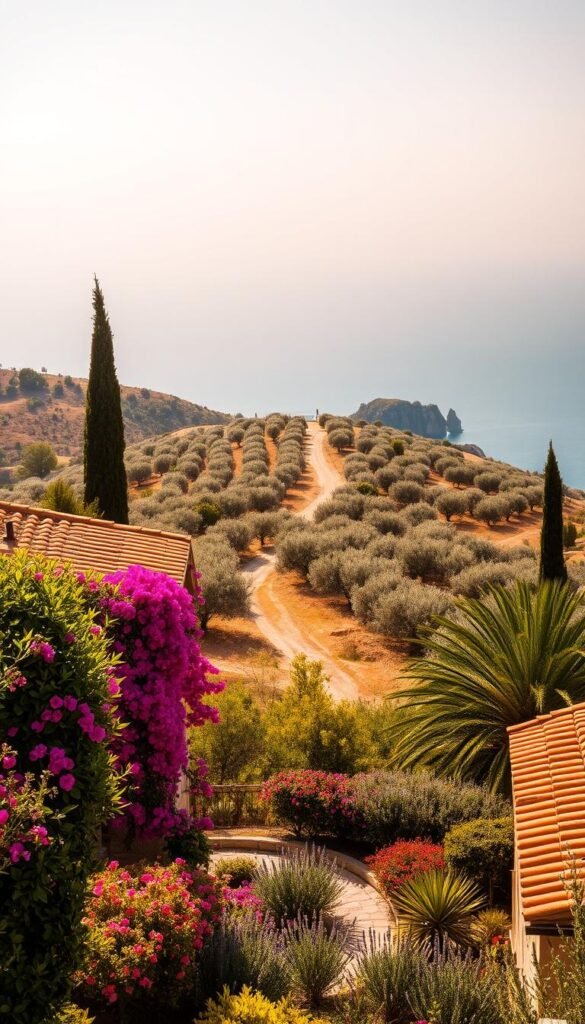
Discover how smart layouts turn harsh sunlight into cozy retreats. These outdoor spaces thrive by blending practicality with beauty—every choice combats heat while creating visual appeal. Stone walls deflect warmth, gravel paths reduce water use, and shaded pergolas become natural air conditioners.
- Shade sails that double as artistic focal points
- Bubbling fountains cooling nearby seating zones
- Raised terraces using local stone for better airflow
Texture plays a starring role. Crushed limestone underfoot stays cooler than concrete, while rough-hewn benches invite lingering. As one landscape architect notes: “These spaces don’t fight the climate—they dance with it.”
Even small yards benefit from layered elevations. Tiered planters create microclimates for herbs and citrus trees. Winding pathways lead to intimate seating nooks, making every square foot purposeful. The result? A landscape that feels both timeless and tailored to modern life.
Adaptability shines through in material choices. Sun-bleached wood complements modern homes, while terracotta pots add rustic charm to urban balconies. This approach proves coastal-inspired features work anywhere—you just need the right balance of shade, texture, and airflow.
Selecting Materials, Colors, and Textures
The secret to authentic coastal charm lies in your material and color choices. Every surface tells a story through its finish, shade, and feel—creating layers of visual interest that withstand both time and weather.
Terracotta, Stone, and Natural Finishes
Start with earthy elements that develop character over years. Oversized terracotta urns make striking focal points, while gravel paths crunch satisfyingly underfoot. Combine rough-cut limestone walls with smooth stucco surfaces for contrast that catches the eye.
Three materials work hardest in these spaces:
- Warm-toned stone for retaining walls and patios
- Weathered wood beams supporting pergolas
- Handmade clay pots in varying sizes
Warm Hues and Sun-Drenched Palettes
Bold colors shine under bright skies. Paint gates cobalt blue to mimic sea depths, or choose mustard yellow cushions that pop against neutral backdrops. Balance vibrant tiles with sandy beige gravel to prevent visual overload.
Follow this simple formula for harmony:
60% neutral tones (cream, taupe) + 30% earthy reds + 10% accent blues. This ratio keeps spaces lively yet relaxing—perfect for long afternoons outdoors.
Remember: textures matter as much as colors. Pair glossy ceramic tiles with matte terracotta planters. Let iron lanterns develop a rust patina. These organic changes add depth you can’t fake.
Designing Inviting Outdoor Living Spaces
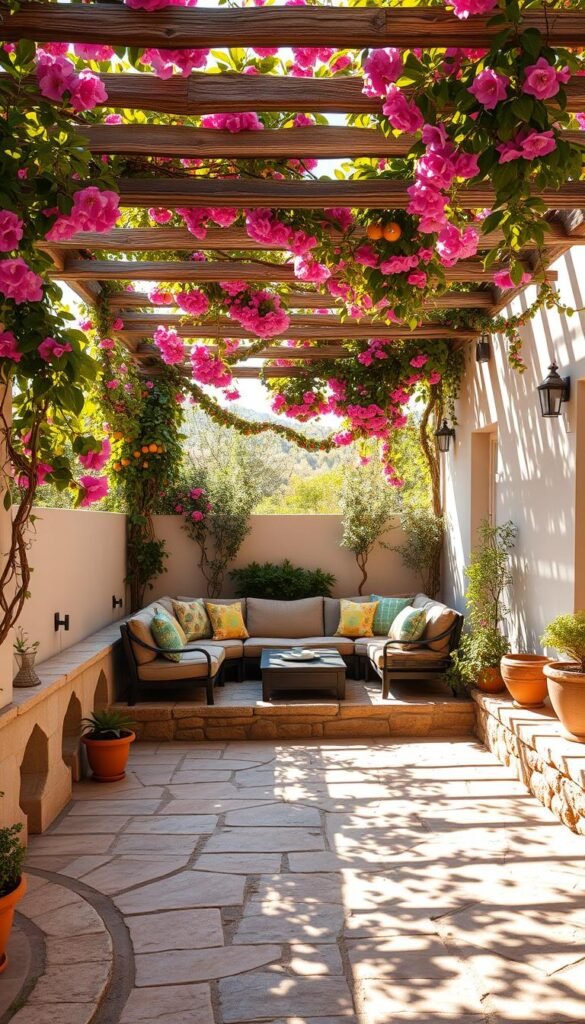
Your patio becomes a natural extension of indoor comfort when planned with intention. These spaces thrive on layered elements that invite lingering—think plush cushions under shaded structures or dining spots framed by fragrant greenery.
Crafting Zones for Connection
Start by mapping living areas that serve distinct purposes. A sun-drenched breakfast nook might feature wrought-iron chairs, while evening seating clusters gather around fire pits. Smart zoning creates rooms without walls, each with its own mood.
Consider these pairings for multi-functional space:
| Zone Purpose | Key Furniture | Texture Mix |
|---|---|---|
| Casual Dining | Teak Table + Bench | Linen + Woven Rugs |
| Relaxation | Daybed + Side Tables | Weatherproof Velvet + Stone |
| Entertaining | Modular Sectional | Ceramic Lamps + Iron |
Lighting transforms patios from day to night. String bulbs cast warm glows over dining areas, while lanterns create intimate pools of light. As designer Elena Marquez notes: “Outdoor rooms should feel discovered, not decorated—every choice whispers ‘stay awhile.'”
You’ll want to layer textures that withstand seasons. Sun-faded cushions gain character, while powder-coated metals resist rust. The goal? A sense of ease that makes every meal or conversation feel like time well spent.
Incorporating Water Features and Shade Solutions
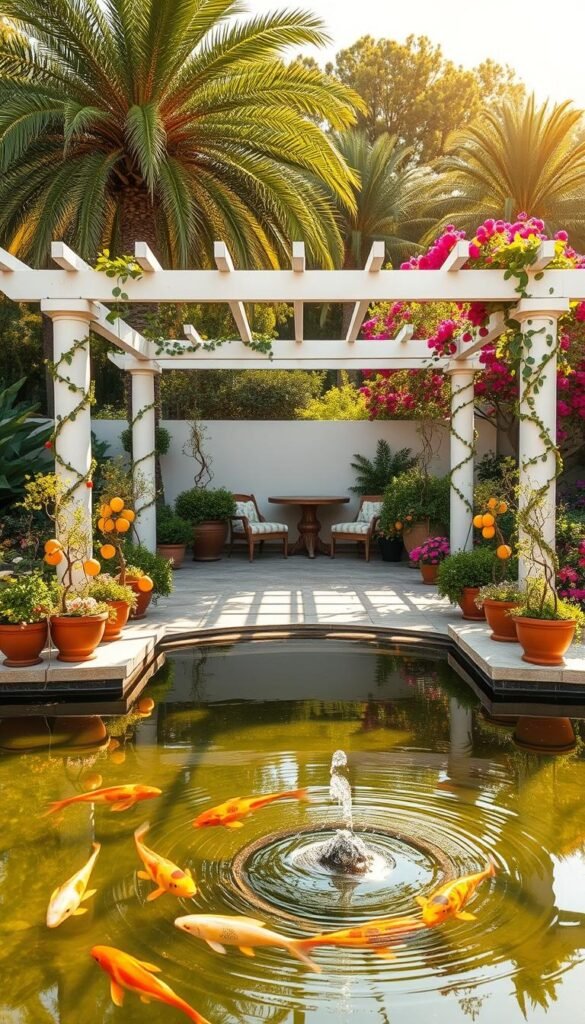
Cool breezes and dappled sunlight become your garden’s greatest assets when paired thoughtfully. Water elements and shade structures work together to create refreshing escapes that balance sun-soaked areas.
Fountains, Pools, and Misting Options
Water features do double duty—they cool the air while adding movement and sound. A tiered fountain becomes a natural humidifier, its cascading flow masking street noise. For smaller spaces, wall-mounted spouts or birdbaths offer similar benefits without dominating the area.
Consider these factors when choosing:
- Recirculating pumps for eco-friendly operation
- Materials like aged copper or local stone that blend with your layout
- Placement near seating zones to maximize cooling effects
Pergolas, Arbors, and Shaded Retreats
Shade structures transform harsh sunlight into soft patterns. Train grapevines across wooden beams—their leaves filter light while providing edible rewards. Metal arbors with climbing roses add vertical interest and fragrance.
Key benefits of strategic shading:
- Reduces surface temperatures by up to 20°F
- Creates intimate spaces perfect for compact areas
- Extends outdoor living hours during peak heat
Pair a stone bench under your pergola with a nearby water feature. The combo delivers natural air conditioning—gentle mist meets cross-breezes through leafy canopies. It’s how coastal dwellers have stayed cool for centuries, now adapted for modern backyards.
Choosing Drought-Tolerant Plants and Fragrances
What if your outdoor space could thrive with minimal watering while delighting your senses? Drought-resistant varieties bring texture, color, and fragrance to sun-baked areas. Their secret lies in clever adaptations—silver-toned leaves reflect heat, while deep roots seek moisture far below parched surfaces.
Aromatic Herbs and Colorful Blooms
Your herb corner becomes a sensory powerhouse. Rosemary releases its pine-like scent when brushed against, while lavender’s purple spikes attract buzzing pollinators. These multitaskers thrive in rocky soil and handle summer neglect with ease.
| Plant Type | Key Benefit | Care Tip |
|---|---|---|
| Lavender | Deer-resistant fragrance | Prune after flowering |
| Thyme | Edible ground cover | Full sun required |
| Oregano | Culinary versatility | Divide every 3 years |
Olive Trees, Citrus, and Succulents
Mature olive trees become living sculptures with gnarled trunks and silvery foliage. Pair them with potted lemon trees for zesty aromas. For compact patios, try agave varieties in terra cotta pots—their geometric forms need water only monthly.
Succulents like echeveria offer rosette shapes in blues and purples. Combine them with lamb’s ear for fuzzy texture contrast. As landscape designer Mia Torres advises: “Group plants by water needs—it simplifies care and creates natural visual flow.”
Implementing Sustainable and Low Maintenance Practices
Creating an oasis that thrives with minimal effort starts with smart water management. By focusing on efficient systems and strategic care, you’ll spend less time maintaining your space while enjoying its beauty year-round.
Water-Wise Irrigation Techniques
Drip systems deliver moisture directly to plant roots, cutting water use by up to 35%. Pair them with rain barrels to capture runoff—your soil stays nourished without waste. For new plants, water deeply during their first season, then gradually reduce frequency as roots establish.
Layering gravel around shrubs keeps roots cool and suppresses weeds. Studies show this simple step lowers watering needs by 25%. Combine it with timed sprinklers set for dawn hours to prevent leaf scorch.
Prune strategically to maintain plant health and shape. This reduces maintenance while encouraging lush growth. Those in warm regions can boost efficiency using square foot techniques tailored for water conservation.
With these methods, your outdoor area becomes self-sufficient. You gain more time to relax while supporting local ecosystems—a win for you and the planet.

